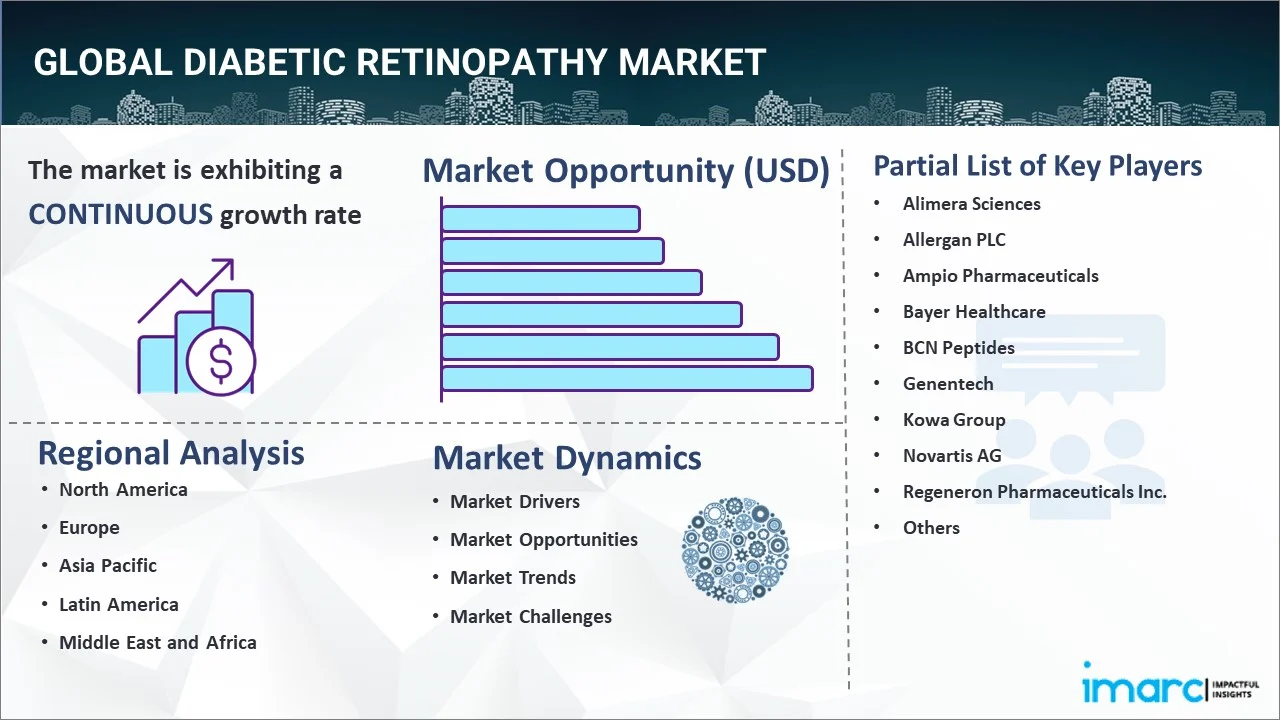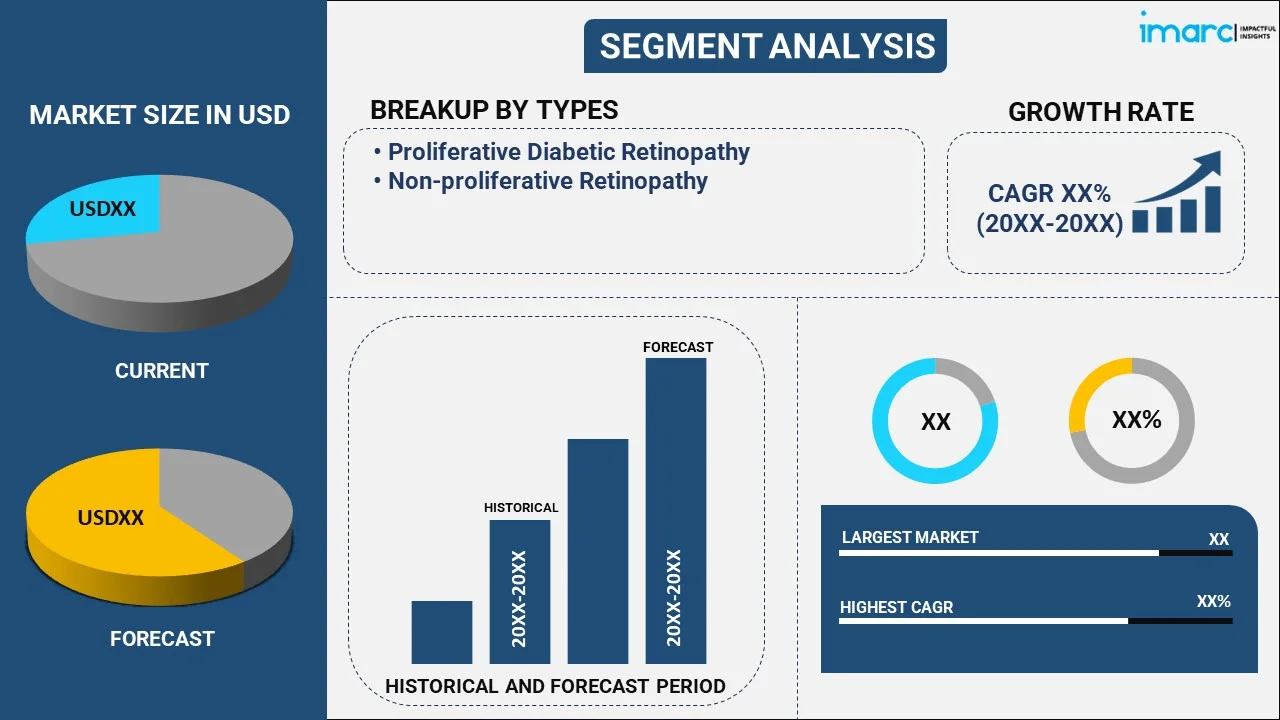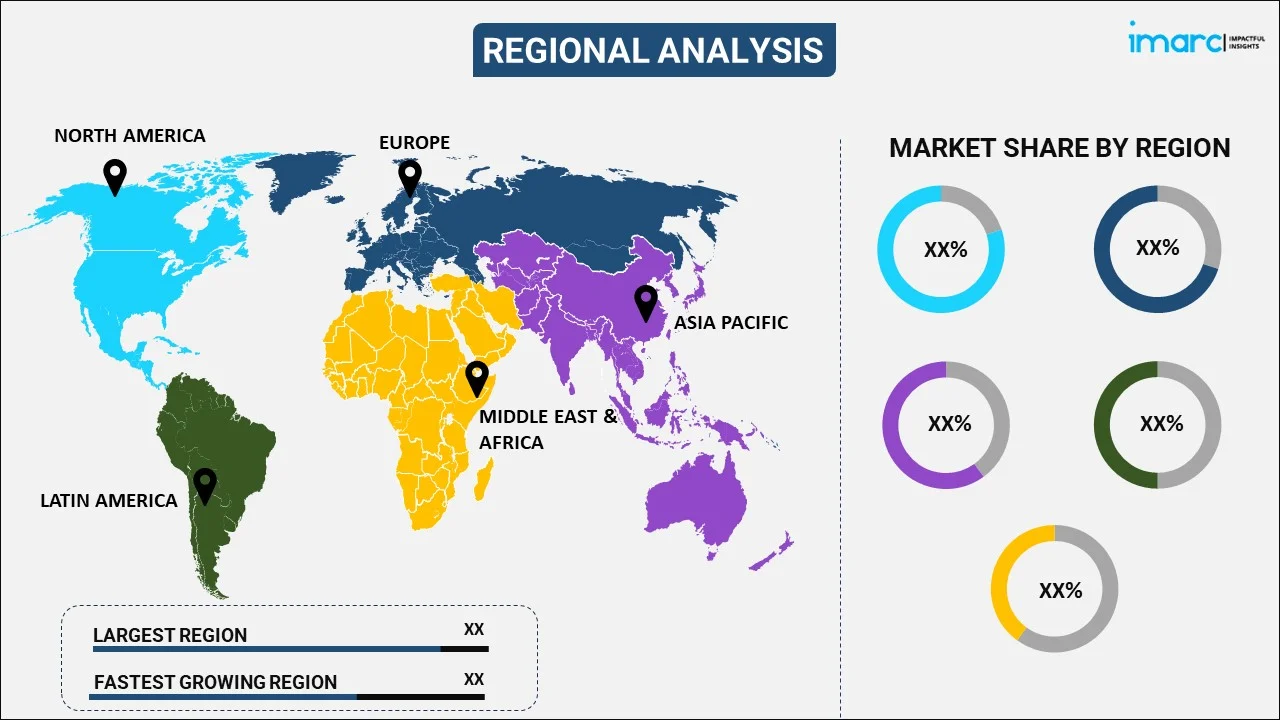
Diabetic Retinopathy Market Report by Type (Proliferative Diabetic Retinopathy, Non-proliferative Retinopathy), Treatment Type (Anti VEGF Drugs, Steroid Implants, Laser Surgeries, Vitrectomy), End-User (Hospitals and Pharmacies, Eye Clinics, Ambulatory Surgical Centres (ASCs), and Others), and Region 2025-2033
Market Overview:
The global diabetic retinopathy market size reached USD 8.5 Billion in 2024. Looking forward, IMARC Group expects the market to reach USD 13.2 Billion by 2033, exhibiting a growth rate (CAGR) of 5% during 2025-2033. The surging prevalence of diabetes, rising demand for effective treatments, and growing awareness regarding early diagnosis and treatment of diabetic retinopathy represent some of the key factors driving the market.
|
Report Attribute
|
Key Statistics
|
|---|---|
|
Base Year
|
2024
|
|
Forecast Years
|
2025-2033
|
|
Historical Years
|
2019-2024
|
|
Market Size in 2024
|
USD 8.5 Billion |
|
Market Forecast in 2033
|
USD 13.2 Billion |
| Market Growth Rate 2025-2033 | 5% |
Diabetic retinopathy (DR) is a common complication of diabetes that affects the retina, the part of the eye that senses light and sends signals to the brain. It occurs when high blood sugar levels damage the small blood vessels in the retina, causing them to leak or become blocked. This can lead to vision loss or blindness if left untreated. There are two main types of diabetic retinopathy, namely non-proliferative diabetic retinopathy and proliferative diabetic retinopathy. Its diagnosis involves a comprehensive eye exam, which may include tests such as fluorescein angiography and optical coherence tomography. These tests can help to identify the presence and severity of DR, allowing for early intervention and treatment. Currently, there are several treatment options available for DR, including the use of intraocular steroid injections, laser treatment, and vitrectomy. Intraocular steroid injections can help to reduce inflammation and swelling in the eye, while laser treatment can be used to seal leaking blood vessels and prevent further damage to the retina. In more severe cases, a vitrectomy may be necessary to remove blood or scar tissue from the eye.

Diabetic Retinopathy Market Trends:
The global diabetic retinopathy market is witnessing significant growth, primarily driven by the rising prevalence of diabetes and the increasing geriatric population. In line with this, key players are actively working to develop new therapeutic solutions for diabetic retinopathy, which is bolstering market growth. Apart from this, the development of new drugs and therapies, such as anti-VEGF agents and sustained-release implants, has also significantly contributed to market growth. Additionally, the escalating adoption of telemedicine and artificial intelligence (AI) in the diagnosis and treatment of diabetic retinopathy is driving the market growth. The rising demand for effective treatments due to the growing awareness of diabetic retinopathy and its potential consequences is acting as another growth-inducing factor. Furthermore, the surging awareness regarding early diagnosis and treatment of diabetic retinopathy, coupled with advancements in ophthalmic technology, are fueling the market growth. Other factors, such as increasing healthcare expenditure, the implementation of various government initiatives to improve eye care services, and the availability of favorable reimbursement policies, are propelling the market growth.
Key Market Segmentation:
IMARC Group provides an analysis of the key trends in each sub-segment of the global diabetic retinopathy market report, along with forecasts at the global, regional and country level from 2025-2033. Our report has categorized the market based on type, treatment type and end-user.
Type Insights:

- Proliferative Diabetic Retinopathy
- Non-proliferative Retinopathy
The report has provided a detailed breakup and analysis of the diabetic retinopathy market based on the type. This includes proliferative diabetic retinopathy and non-proliferative retinopathy. According to the report, the non-proliferative retinopathy segment dominates the market.
Treatment Type Insights:
- Anti VEGF Drugs
- Steroid Implants
- Laser Surgeries
- Vitrectomy
The report has provided a detailed breakup and analysis of the diabetic retinopathy market based on the treatment type. This includes anti VEGF drugs, steroid implants, laser surgeries, and vitrectomy. As per the report, the anti VEGF drugs segment holds the largest market share.
End-User Insights:
- Hospitals and Pharmacies
- Eye Clinics
- Ambulatory Surgical Centres (ASCs)
- Others
The report has provided a detailed breakup and analysis of the diabetic retinopathy market based on the end-user. This includes hospitals and pharmacies, eye clinics, ambulatory surgical centres (ASCS), and others. As per the report, the hospitals and pharmacies segment leads the market.
Regional Insights:

- North America
- United States
- Canada
- Asia Pacific
- China
- Japan
- India
- South Korea
- Australia
- Indonesia
- Others
- Europe
- Germany
- France
- United Kingdom
- Italy
- Spain
- Russia
- Others
- Latin America
- Brazil
- Mexico
- Others
- Middle East and Africa
The report has also provided a comprehensive analysis of all the major regional markets, which include North America (the United States and Canada); Europe (Germany, France, the United Kingdom, Italy, Spain, Russia, and others); Asia Pacific (China, Japan, India, South Korea, Australia, Indonesia, and others); Latin America (Brazil, Mexico, and others); and the Middle East and Africa. As per the report, North America dominates the market. Some of the factors accelerating the North America diabetic retinopathy market include the increasing prevalence of diabetes, growing awareness about diabetic retinopathy, and advancements in diagnostic and treatment technologies.
Competitive Landscape:
The report has also provided a comprehensive analysis of the competitive landscape in the global diabetic retinopathy market. Competitive analysis such as market structure, market share by key players, player positioning, top winning strategies, competitive dashboard, and company evaluation quadrant has been covered in the report. Also, detailed profiles of all major companies have been provided. Some of the companies covered include Alimera Sciences, Allergan PLC, Ampio Pharmaceuticals, Bayer Healthcare, BCN Peptides, Genentech, Kowa Group, Novartis AG, Regeneron Pharmaceuticals Inc., Sirnaomics Inc., etc. Kindly note that this only represents a partial list of companies, and the complete list has been provided in the report.
Report Coverage:
| Report Features | Details |
|---|---|
| Base Year of the Analysis | 2024 |
| Historical Period | 2019-2024 |
| Forecast Period | 2025-2033 |
| Units | Billion USD |
| Segment Coverage | Type, Treatment Type, End-User, Region |
| Region Covered | Asia Pacific, Europe, North America, Latin America, Middle East and Africa |
| Countries Covered | United States, Canada, Germany, France, United Kingdom, Italy, Spain, Russia, China, Japan, India, South Korea, Australia, Indonesia, Brazil, Mexico |
| Companies Covered | Alimera Sciences, Allergan PLC, Ampio Pharmaceuticals, Bayer Healthcare, BCN Peptides, Genentech, Kowa Group, Novartis AG, Regeneron Pharmaceuticals Inc. and Sirnaomics Inc. |
| Customization Scope | 10% Free Customization |
| Post-Sale Analyst Support | 10-12 Weeks |
| Delivery Format | PDF and Excel through Email (We can also provide the editable version of the report in PPT/Word format on special request) |
Key Questions Answered in This Report:
- How has the global diabetic retinopathy market performed so far, and how will it perform in the coming years ?
- What are the drivers, restraints, and opportunities in the global diabetic retinopathy market ?
- What is the impact of each driver, restraint, and opportunity on the global diabetic retinopathy market ?
- What are the key regional markets ?
- Which countries represent the most attractive diabetic retinopathy market ?
- What is the breakup of the market based on the type ?
- Which is the most attractive type in the diabetic retinopathy market ?
- What is the breakup of the market based on the treatment type ?
- Which is the most attractive treatment type in the diabetic retinopathy market ?
- What is the breakup of the market based on the end-user ?
- Which is the most attractive end-user in the diabetic retinopathy market ?
- What is the competitive structure of the global diabetic retinopathy market ?
- Who are the key players/companies in the global diabetic retinopathy market ?
Key Benefits for Stakeholders:
- IMARC’s report offers a comprehensive quantitative analysis of various market segments, historical and current market trends, market forecasts, and dynamics of the diabetic retinopathy market from 2019-2033.
- The research study provides the latest information on the market drivers, challenges, and opportunities in the global diabetic retinopathy market.
- The study maps the leading, as well as the fastest-growing, regional markets. It further enables stakeholders to identify the key country-level markets within each region.
- Porter's five forces analysis assist stakeholders in assessing the impact of new entrants, competitive rivalry, supplier power, buyer power, and the threat of substitution. It helps stakeholders to analyze the level of competition within the diabetic retinopathy industry and its attractiveness.
- Competitive landscape allows stakeholders to understand their competitive environment and provides an insight into the current positions of key players in the market.
Need more help?
- Speak to our experienced analysts for insights on the current market scenarios.
- Include additional segments and countries to customize the report as per your requirement.
- Gain an unparalleled competitive advantage in your domain by understanding how to utilize the report and positively impacting your operations and revenue.
- For further assistance, please connect with our analysts.
 Inquire Before Buying
Inquire Before Buying
 Speak to an Analyst
Speak to an Analyst
 Request Brochure
Request Brochure
 Request Customization
Request Customization




.webp)




.webp)












